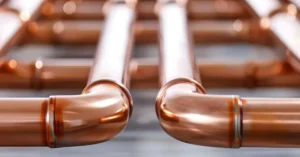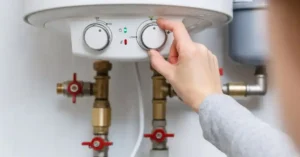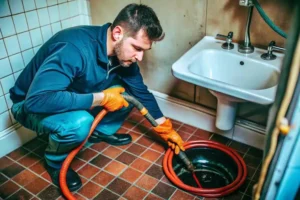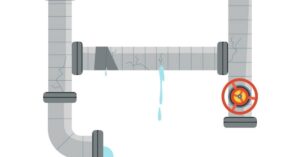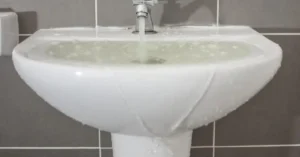Switching to an on-demand hot water system brings many benefits, from energy savings to space recovery. The idea of limitless hot water is appealing, but the installation demands precision, especially when replacing older tank style water heaters. This complete guide details the process and the critical considerations.
For homeowners determined to upgrade their system they need to understand how to install tankless water heater correctly. This project is complex, involving plumbing, gas, or electrical work. Proper tankless installation is non-negotiable for safety and efficiency.
What Is a Tankless Water Heater?

A tankless water heater, often called an on-demand or instant hot water heater, heats water only when you need it. Unlike traditional water heater models that store and continuously heat a large tank of water, a tankless unit waits for a hot water faucet to open.
When water flow starts, the unit activates a powerful heating element either gas burners or electric coils. The cold water runs through a heat exchanger, reaching your desired temperature almost instantly. It delivers a continuous supply of hot water until the faucet is closed. These compact units dramatically reduce the energy waste tied to keeping a tank water hot 24/7.
Benefits of a Tankless Water Heater
Endless Hot Water Supply
Tankless systems heat water continuously. A properly sized unit provides hot water for multiple showers, laundry, and dishes at the same time. You’ll never wait for a tank to refill and reheat.
Lower Energy Costs
These units only heat water when needed. Traditional tanks constantly reheat stored water, wasting energy. Studies show tankless models reduce water heating costs by 24-34% for homes using 41 gallons or less daily.
Space Savings
Wall-mounted tankless units free up valuable floor space. Perfect for small homes, apartments, or utility closets. Some homeowners install them in tight spaces like under stairs or in crawl spaces.
Longer Lifespan
Tankless water heaters typically last 20+ years with proper maintenance. Traditional tanks rust out after 10-15 years. The longer life span offsets the higher upfront cost.
Reduced Risk of Water Damage
No tank means no catastrophic tank ruptures. You won’t come home to 50 gallons of water flooding your basement.
What Should You Consider For The Installation Process?
Fuel Type and Availability
Check what utilities serve your home. Gas tankless units require an existing natural gas line or propane tank. Electric models need adequate electrical capacity. Gas units typically heat water faster and cost less to operate in most areas.
Flow Rate Requirements
Calculate your household’s peak demand. Count how many fixtures might run simultaneously. A typical shower uses 2.5 gallons per minute (GPM). Add washing machines (2-3 GPM) and dishwashers (1-2 GPM). Choose a unit that handles your total peak flow rate.
Temperature Rise Needed
This measures how much the unit must heat incoming water. Subtract your groundwater temperature from your desired output temperature (usually 120°F). Cold climate homes need units with higher BTU ratings to achieve proper temperature rise.
Venting Requirements
Gas tankless water heater venting is critical for safety. Most units require category III stainless steel venting or PVC pipes rated for high temperatures. Plan your vent route to the exterior with minimal bends. Direct vent models pull combustion air from outside, while power vent units use a fan to expel gases.
Location Selection
Choose a spot close to where you use hot water most. Shorter pipe runs mean faster hot water delivery and less heat loss. The location needs access to gas lines, water lines, electrical power, and exterior walls for venting.
Permit Requirements
Most municipalities require permits for tankless hot water installation. Gas installations always need permits and inspections. Contact your local building department before starting work.
Electrical Needs
Even gas units need electricity for electronic ignition and controls. Standard 120V outlets work for most gas models. Electric tankless units may require 240V circuits with 60-150 amp service, depending on size.
Tools and Materials Needed
Proper tankless installation requires a specific set of tools and materials. Having everything ready saves time and ensures a smooth process.
Tools
- Pipe cutters or tubing cutters
- Adjustable wrenches and pipe wrenches
- Propane torch and solder (for copper pipes)
- Drill and appropriate bits
- Level and tape measure
- Voltage tester (for electric units)
- Gas leak detector or soapy water solution (for gas units)
Materials
- The new tankless water heater unit
- Isolation Valve Kit (essential for future maintenance and flushing)
- Mounting hardware (usually included with the unit)
- Appropriate piping (copper or PEX, with fittings)
- Gas connector and black iron pipe (for gas units)
- Approved venting materials (stainless steel, PVC, or polypropylene)
- T&P (Temperature and Pressure) relief valve
- Pipe thread sealant (Teflon tape or pipe dope)
- Drain line materials (for condensate in condensing units)
- Expansion tank (may be required depending on local code or your water system)
Step-by-Step Guide: How to Install Tankless Water Heater

This guide assumes you are replacing an existing tank style water heaters. The complexity of this project means this is a general overview; always follow the manufacturer’s instructions exactly.
Step 1: Shut Off and Remove the Old Water Heater
Safety comes first. Turn off the water supply at the main shut-off valve. For gas units, turn off the gas at the appliance shut-off valve and the main supply. For electric units, turn off the circuit breaker.Drain the old tank completely using a hose attached to the drain valve. Once drained, disconnect the water lines, gas line, or electrical wiring. Dispose of the old water heater safely and according to local rules.
Step 2: Mount the Tankless Unit
Select a location that meets the manufacturer’s clearance requirements for venting, accessibility, and service. Gas units must be near an exterior wall. Use the provided template and mounting bracket to secure the unit to the wall. Make sure the wall can support the unit’s weight, especially when full of water. Use a level to ensure it is perfectly straight.
Step 3: Install the Water and Isolation Valves
Tankless units require service or isolation valves on both the hot and cold lines for maintenance. Install the isolation valve kit onto the inlet (cold) and outlet (hot) ports of the unit.Connect your home’s existing cold water supply line to the cold inlet valve and the hot water distribution line to the hot outlet valve. Use appropriate fittings and sealants to prevent leaks. The plumbing should be neat and well-supported.
Step 4: Install the Gas Line or Electrical Supply
This step is the most critical and often requires professional help for proper tankless hot water install.
- For Gas Units: Connect the gas supply line to the unit’s gas inlet. As mentioned, you may need to upgrade the gas line. Install a sediment trap (drip leg) before the unit’s connection point. Use pipe thread sealant on all fittings.
- For Electric Units: Install the dedicated circuit(s) and proper gauge wiring from your breaker panel to the unit. Connect the wires according to the manufacturer’s wiring diagram.
Step 5: Install the Venting System
Proper tankless water heater venting is vital for gas units to safely expel combustion gases.Run the manufacturer-approved vent piping from the unit to the outside termination point. Follow the specified minimum and maximum vent lengths, as well as the required pitch for drainage. Ensure the vent termination meets local code requirements for distance from doors, windows, and air intakes. Condensing units also require a drain line for acidic condensate, which must run to a suitable drain.
Step 6: Test and Purge the System
Before firing up the heater, open the cold water isolation valve. Slowly turn on the main water supply to allow the unit and plumbing to fill. Open all hot water faucets in the house to purge air from the lines. Run the water until the flow is steady and free of sputtering. This crucial step prevents damage.
Step 7: Final Startup and Leak Check
For gas units, turn the gas back on and test all gas connections for leaks using a gas leak detector or soapy water. For electric units, flip the breaker. Follow the start-up procedure in the manual. Turn on a hot water faucet and confirm the unit fires up and maintains a steady hot water flow. Congratulations, now you know how to install tankless water heater systems, at least on paper.
You can read about: How to Install a Heat Pump Water Heater
How Much Does It Cost to Install a Tankless Water Heater?
The total cost for tankless water heater installation ranges from $1,800 to $6,500, depending on several factors.
Unit Costs:
- Electric tankless heaters: $500-$1,500
- Gas tankless heaters: $800-$2,500
- Whole-house models cost more than point-of-use units
Labor Costs:
- Professional installation: $1,000-$3,000
- Complex installations requiring significant upgrades: $3,000-$4,000
Additional Expenses:
- Electrical panel upgrade: $1,000-$2,500
- Gas line installation or upgrade: $500-$1,500
- Venting system materials: $300-$800
- Water softener (for hard water areas): $800-$2,500
- Permits and inspections: $100-$500
- Expansion tank: $150-$300
Converting from electric to gas (or vice versa) increases costs significantly due to infrastructure changes. Expect to pay $2,000-$4,000 extra for fuel type conversions.
Point-of-use units for single fixtures cost much less. A small electric unit with installation runs $400-$1,000. These make sense for remote bathrooms or additions.
Factor in long-term savings. Most homeowners recoup installation costs through energy savings in 6-10 years. Federal tax credits may also apply, reducing your net cost by up to $2,000.
Common Installation Mistakes to Avoid
Undersizing the Unit
The biggest mistake is buying a unit too small for your needs. Calculate your peak demand carefully. A family of four typically needs at least 7-8 GPM capacity. Undersized units can’t maintain temperature when multiple fixtures run simultaneously.
Ignoring Groundwater Temperature
A unit rated for 5 GPM assumes specific conditions. In cold climates where groundwater enters at 40°F, that same unit might only deliver 3 GPM at 120°F. Check your region’s average groundwater temperature and size accordingly.
Improper Venting
Using incorrect venting materials causes dangerous carbon monoxide buildup. Only use manufacturer-approved venting. Never connect to an old chimney without proper liner installation. Condensing tankless units need condensate drains, not just exhaust vents.
Inadequate Gas Supply
Tankless units need substantial gas flow. Your existing 1/2-inch gas line probably won’t work. Most units require 3/4-inch minimum. Running too-small gas lines causes poor performance and incomplete combustion.
Skipping the Expansion Tank
Closed water systems (those with backflow prevention valves or pressure regulators) need expansion tanks. Without one, pressure buildup can damage the tankless unit and plumbing fixtures.
Poor Location Choice
Installing units far from main water use points wastes water and energy. You’ll wait longer for hot water and lose heat through long pipe runs. Place units centrally or use multiple point-of-use units.
Forgetting Water Quality
Hard water destroys tankless water heaters. Mineral deposits clog heat exchangers. Install a water softener or plan annual descaling maintenance. Ignoring water quality voids most warranties.
DIY Electrical Upgrades
Electric tankless water heater setup requires serious electrical knowledge. These units draw 80-150 amps. Improper wiring causes fires. Hire a licensed electrician for electrical work.
Not Following Code
Local building codes exist for safety. Skipping permits leads to fines, failed inspections, and insurance claim denials. Always pull proper permits and schedule inspections.
Inadequate Ventilation Clearance
Vent terminations need specific clearances from windows, doors, and air intakes. Installing too close creates carbon monoxide hazards and violates codes.
When to Hire a Professional
Certain situations demand professional tankless hot water installation. Here’s when to call the experts:
Complex Gas Work
Installing or modifying gas lines requires specialized knowledge and tools. Licensed plumbers carry proper insurance and are familiar with gas codes. Mistakes cause explosions, fires, or carbon monoxide poisoning.
Major Electrical Upgrades
If your electrical panel lacks capacity for an electric tankless unit, hire a licensed electrician. Panel upgrades involve working with high-voltage electricity. One mistake can be fatal.
Permit and Inspection Requirements
Professionals know local codes and handle permitting. They ensure work passes inspection the first time. Failed DIY inspections mean redoing work and paying additional fees.
Venting Through Finished Spaces
Running new vents through walls, ceilings, or roofs requires carpentry skills. Improper sealing causes water damage and mold growth. Professionals have tools to minimize damage and restore surfaces properly.
Converting Fuel Types
Switching from gas to electric (or vice versa) involves major changes. Gas line capping, electrical upgrades, and venting removal need professional expertise.
Warranty Protection
Many manufacturers require professional installation to honor warranties. DIY installation might void your warranty, leaving you unprotected against defects.
Time and Tool Constraints
Professional plumbers complete installations in 4-8 hours. DIYers might spend entire weekends learning and troubleshooting. Specialized tools like pipe threaders and gas pressure testers cost hundreds to buy.
Water Quality Issues
Homes with hard water, high sediment, or mineral content need proper system design. Professionals recommend appropriate filtration, softening, and maintenance schedules.
You can save money doing prep work yourself. Remove the old tank, clear the installation area, and paint or patch walls before the plumber arrives. This reduces labor hours while keeping critical work in professional hands.
Find A Local Water Heater Professionals
If you are not comfortable handling the complex plumbing, gas, and venting aspects, engaging an experienced, licensed plumbing service is the safest choice. For expert, reliable tankless water heater installation in Eagle Rock you need a local specialist.
Consider calling a trusted company like Derks Plumbing. Our professional team will ensure your new unit sized, installed, and vented correctly, protecting your investment and your family’s safety. They provide the expertise you need to get the job done right the first time.
Conclusion
Installing a tankless water heater is a rewarding home improvement project that provides efficiency, space savings, and endless hot water. The key to a successful tankless installation is meticulous planning, especially around sizing and required infrastructure upgrades for the gas or electrical supply. Understanding how to install tankless water heater involves complex tasks like gas line sizing and proper tankless water heater venting.
The technical demands of the job often justify bringing in a professional. Choosing to install a tankless system is a long-term investment that brings your home into a new era of energy-efficient hot water supply.
FAQs
Is it worth it to replace a regular water heater with a tankless one?
Yes, it is worth it for most homeowners. While the upfront cost to install a tankless water heater is higher, the long-term energy savings and the unit’s doubled lifespan typically offset the initial expense. You also get the major benefit of unlimited tankless hot water.
Do all tankless water heaters require an expansion tank?
No. An expansion tank is typically required when the plumbing system includes a backflow preventer or a pressure reducing valve, creating a “closed-loop” system. Local plumbing codes dictate this requirement, so always check your local rules.
How often does a tankless water heater need maintenance?
Gas and electric units should be flushed annually by a professional. This flushing removes mineral scale and sediment that build up in the heat exchanger, ensuring peak efficiency and extending the life of the unit. This process requires the isolation valves to be installed.
How long does it take to install a tankless water heater?
For a simple replacement that does not require extensive gas line or electrical upgrades, a professional tankless hot water installation generally takes between 4 to 8 hours. If major upgrades like a new gas line or electrical service are needed, the project can take one to two full days.
Can I get an electric tankless water heater for a whole house?
Yes, but whole-house electric tankless units require a very high electrical load, often needing multiple high-amperage, dedicated 240-volt circuits. Many older homes require a costly electrical panel upgrade to support the demand of a whole-house electric tankless water heater setup.


